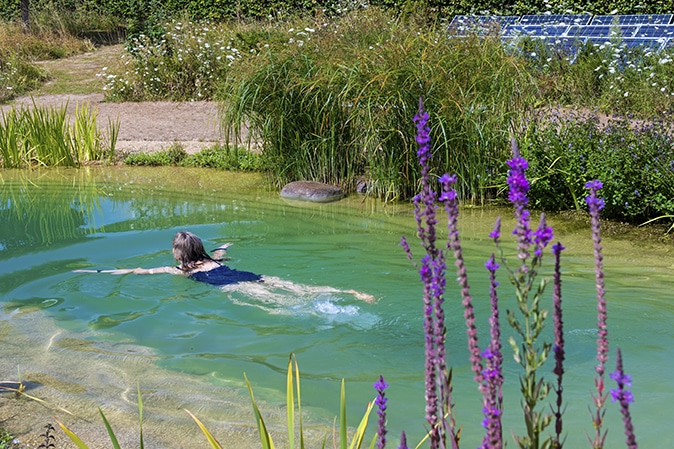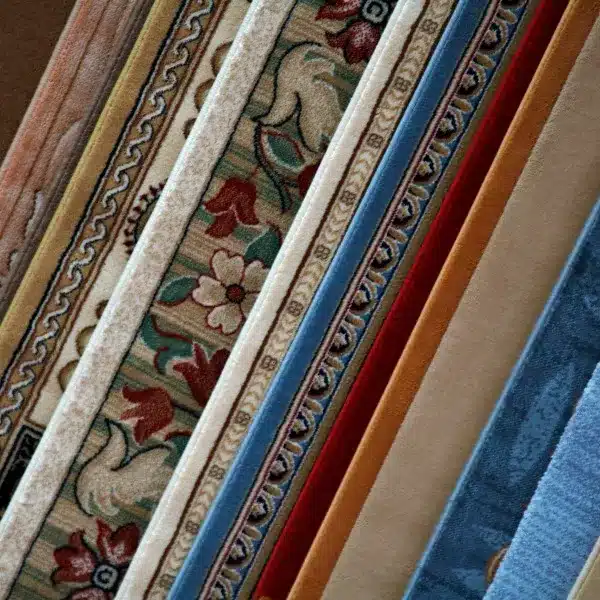How to Create a Sustainable, Non-Toxic Yard
Written by:
John Goss
07/08/2023

Updated: 02/20/2024
Looking for a different guide? Browse them all HERE.
If you’re a regular reader, you may already have a non-toxic yard, since you likely know about the well-established dangers of lawn care chemicals. However, even for those of you doing everything to protect your family with a non-toxic yard, there may be more you can do to make your yard truly eco-friendly. Read on for my favorite ideas!
The Problem with Yards
Chemical fertilizers and pest control sprays are not only dangerous for our kids and pets who play in our yards. These toxins can also be devastating to wildlife, including birds, pollinators, and all the organisms–large and microscopic–that give life to the soil.
Moreover, American lawns annually consume approximately 20 trillion gallons of water, 80 million pounds of pesticides, 90 million pounds of fertilizer, and 600 million gallons of fossil fuels (source). It’s also estimated that all those pesticides and fertilizers kill 7 million birds each year. (And these stats only apply to lawns, meaning they are not inclusive of the resources used to maintain flowers, shrubs, trees, and gardens!)
Creating a more sustainable, non-toxic yard is a worthy undertaking, but requires a new understanding and view of what a yard really is.

How to Create a Non-Toxic Yard
The good news is that there are ways to eliminate–or at least limit–the toxins in yards. It’s true that organic lawn care can be a bit more expensive in the short run, and the methods yield different results than current typical lawn care. The he first step is to adjust your expectations of what a lawn should be!
What follows are some of our favorite ways to make your lawn less toxic and more planet friendly.
1. Diversify the species of grass in your lawn.
A healthy, nontoxic lawn will include multiple species of ground cover, as opposed to one single species of only grass. Most of us probably believe that a monoculture lawn is the optimal lawn, but you’ll be surprised by how beautiful a more diverse lawn can be. A non-toxic yard will not look like a putting green on a golf course, because unlike a putting green, this lawn will be alive, healthy and primed to support a wide variety of organisms that make for a healthy environment. Ideally, you’ll start by testing your soil to see what specific nutrients yours is lacking. A local nursery in your area should offer these tests and help you apply an amendments to ensure you’re starting with the healthiest soil.
If you do prefer the monoculture look of grass for your lawn, you might consider over-seeding your lawn with micro-clover. Micro clover is a low-growing, dwarf variety of the common Dutch white clover. It grows four to six inches tall and tolerates mowing down to three inches. Grass will grow up through the micro-clover but the two can blend very well together, which creates a uniform appearance. Clover is a legume, which are really good for the soil, other plants, and microorganisms in the soil. Legumes are nitrogen-rich, crowd out weeds, reduce the need for fertilizers and pesticides, attract pollinators, reduce mowing, and discourage diseases and pests. Unfortunately, clover isn’t suitable for every situation, so you’ll want to consult with an expert in your area to help you come up with a plan.

2. Choose organic lawn care products.
Use certified organic lawn care products to allow for biodiversity. Fortunately, there are a lot more of those available than there used to be and they can be easily found at many home/garden centers. There are also increasing numbers of organic lawn maintenance companies that can do all the work for you. Organic fertilizers release nutrients slowly, giving the micro-organisms time to break them down so that the grass can actually use it. But be careful not to over-feed!
Some products we think come in handy when you’re looking to create a non-toxic yard include:
3. Mow differently.
To maintain your non-toxic yard, set your mower to leave at least four inches of grass. This greatly discourages weeds and helps retain moisture. Blades of grass gather sunlight and this feeds the roots, which leads to stronger grass.
When you mow your lawn, leave the clippings in the grass! Raking up clippings is not only a waste of time, but it’s also a waste of money. Lawn clippings are packed with exactly the right nutrients your lawn needs to thrive, and removing them means you’ll have to buy and apply more fertilizer.
If you find the clippings to be unsightly, simply refit your mower with a mulching blade. These blades are designed to not only cut the grass but to also continuously lift the cut grass back up into the mover to be chopped into increasingly finer bits. Those smaller pieces can more easily sift down into your lawn rather than lay on top. This improves the look, decreases the ability of weeds to get started, and rapidly returns nutrients to the soil.
We like this lawnmower for its lack of toxic emissions and powerful mulcher.
4. Don’t rake leaves.
Like mown grass, leaves are actually good for your lawn. Most of us think we need to rake all those leaves and send them to the landfill. Raking is a tedious and time-consuming task, but, yes, a thick carpet of fallen leaves can damage a lawn over time.
Mowing the leaves into the lawn, especially if you use a mulching blade, provides a real boost to your lawn. Worms love chopped up leaves. And a healthy worm population is key to a healthy lawn because worm poop (castings) are packed with vital nutrients for your lawn.
Millions of us buy worm castings to fertilize lawns and plants, but all you really need to do is feed the works that are already there! On top of that, studies also show that mowing your leaves into your lawn can reduce dandelion growth by up to 60%.
Non-Toxic Swimming Pools
Some people replace their lawn with a swimming pool. Traditional pools are dependent on harsh chemicals that are not good for people or the environment. There is, however, a relatively new concept in pools that is catching on in Europe and the Americas. It’s called a swimming pond.
Swimming ponds are not exactly a pond and not exactly a pool. They are a place to swim and hang out in a natural setting that requires no chemical treatments or expensive upkeep. They do, however, require a specific design that combines a pool for swimming with a shallow pool alongside it. The shallow pool has a rocky bottom and is planted with water-plants that are excellent natural filters. The water is constantly but gently pumped from the swimming area into the smaller pool where the plants do their work, sending clean water back to the swimming pool.
These designs encourage, rather than discourage life. With a swimming pond you will see wildlife attracted to the area. If we ever decide to install a pool, it’ll definitely be a swimming pond!
Do You Need a Lawn at All?
Bear with me here. Another way to reduce the toxins in your yard is to minimize or even eliminate the lawn. This can be done in several ways. You could alter your landscape design to increase the percentage of trees, shrubs, and flowers. You can also use ground covers like wild ginger, vetch, pachysandra, ivy and other fast-growing ground cover species.
Some folks seed their lawns with wildflowers and other native species suited to the region. Some even stop mowing altogether. This method can take a couple of years to start looking good, but they can be quite striking as well as really good for all sorts of small critters like birds and pollinators. I’ve done versions of this with mown walking paths that meander around the yard.
Yet another way to minimize lawn is to create a vegetable or flower garden instead of a lawn. You can plant directly into the ground or build raised beds. Yes, vegetable/flower gardens take as much work as a lawn, but the literal fruits of your labors are well worth it. Here are a few images to inspire you!



As you can tell, there are a variety of creative, attractive ways to move away from typical lawn landscaping and end up with a more earth-friendly, non-toxic yard. I’d love to hear what you guys do in your own yards!
Stay sane,


John, Certified Holistic Health Coach
Note: This article contains affiliate links or sponsored content, which means that if you make a purchase, we may earn a commission. We only recommend products that meet our strict standards for non-toxicity and that we use (or want to use!) ourselves. Thank you so much for supporting the brands that make Good Stuff!
Enjoying this guide?
Join 60K families who rely on our free guides on everything from milk to mattresses! Sign up to get $5 off your first order, access to our ultimate Clean Products Cheat Sheet, and ongoing exclusive access to coupon codes and promotions. Our weekly newsletter is filled with well researched tips and tricks to live a toxin-free lifestyle.
Related Posts
How to Choose the Best Air Filter
Shopping for Non Toxic Rugs
Is Most Wallpaper Toxic?
Choosing a Non-Toxic Carpet
2 responses to “How to Create a Sustainable, Non-Toxic Yard”
-
Thank you, John and family, for venturing into recommendations for outside of the home!
On that note, do you have suggestions for companies to reach out to if interested in having an outdoor pond built?
Also, are you open to researching best brands for lawn care and gardening; gardening approaches (e.g., permaculture); etc.? It would really round out the whole non-toxic home research you’ve all compiled over the years! For instance, some might not know that some states (at least here in Oregon) have incentives, whether at the state level, for planting native species, in response to human encroachment and climate change.
Take care, all. 🙂
-
Thanks for the kind words,
We will take a look at your recommendations and see if we can add those to this guide!
Check out pondworks.com, landshapes.net, bionovanaturalpools.com, aquahabitat.com
-






Leave a Reply
You must be logged in to post a comment.